Current Exhibitions
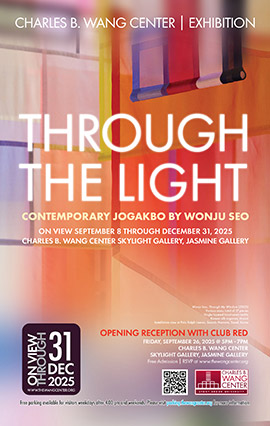
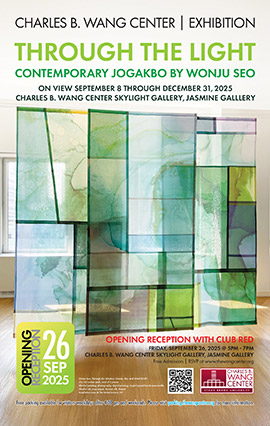
Through the Light: Contemporary Jogakbo by Wonju Seo
On View from September 8 to December 31, 2025 January 31, 2026
Exhibition on View EXTENDED
Charles B. Wang Center Skylight Gallery, Jasmine Gallery
Melding tradition with innovation, Through the Light showcases the contemporary jogakbo (Korean wrapping cloth) art of Wonju Seo. Rooted in centuries-old Korean textile practices, Seo’s translucent compositions transform humble fabric into luminous abstractions. Her works echo the geometry of modernist paintings while inviting viewers to experience light as a living element—passing through seams, shifting with space, and casting ephemeral shadows. With a minimalist sensibility and a reverence for craftsmanship, Seo translates the once utilitarian Korean craft of jogakbo into a contemporary language of transparency, balance, and spiritual reflection.
The Wang Center will host the opening reception for this exhibition with Club Red, an informal gathering for all faculty and staff from every department across Stony Brook University, including both East and West Campuses. Join us for engaging conversations and getting to know each other better over refreshments, good company, and art!
Related Programs
WORKSHOP
The Art of Jogakbo: Korean Patchwork Traditions
Saturday, September 27, 2025 @ 1 PM
East Hall
PERFORMANCE
Shadow Puppet Show: Wrapped Presence
Sunday, November 9, 2025 @ 1 PM & 3 PM
Theatre
Exhibition Opening Reception
Friday, September 26, 2025 @ 5 PM – 7 PM
Skylight Gallery
Free Admission
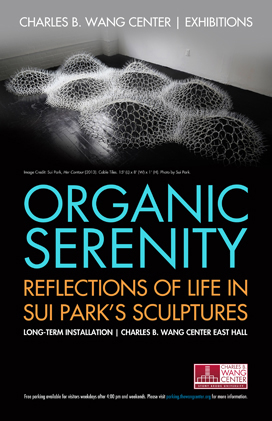
Organic Serenity: Reflections of Life in Sui Park’s Sculptures
Long-Term Installation
Charles B. Wang Center East Hall
Sui Park’s artistic vision revolves around the exploration of the seemingly static yet actually dynamic characteristics that shape our experiences. With the remarkable ability to transform industrial materials into enthralling organic visualizations, Park weaves and connects traces of subtle changes to give rise to breathtaking biomorphic shapes that mirror the transitions and transformations found in nature.
Her choice of materials plays a pivotal role in her creative process. Utilizing industrial materials like monofilament and cable ties, Park breathes new life into otherwise disposable and trivial objects. Through intricate weaving and interconnecting techniques, she transforms these materials into mesmerizing sculptural forms.
You will encounter a collection of artworks that captures the essence of our evolving lives. Each piece serves as a vessel, encapsulating the subtle changes in our emotions, sentiments, memories, and expectations. Park’s organic forms invite contemplation and draw us closer to moments that we may overlook but are truly inspiring.
Nature serves as a wellspring of imagination for Sui Park. For her, it is a space to pause, discover hidden treasures, and seek breakthroughs. By presenting nature in abstract and porous ways, she invites us to fill these spaces with our own thoughts and moments. The exhibition becomes a conduit for reflection to engage with the delicate balance between our experiences and the natural world.
This exhibition is curated by Jinyoung A. Jin, the director of Asian art and culture at the Charles B. Wang Center. All artworks are on loan from Sapar Contemporary, New York.
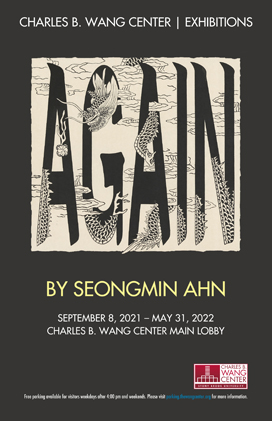
Again by Seongmin Ahn
Long-Term Installation
Charles B. Wang Center Main Lobby
Again is a typographical mural by Brooklyn-based artist Seongmin Ahn, expressing her manifesto of overcoming the global COVID-19 pandemic. The mural is a cross-cultural exchange and community bonds, and it incorporates both Eastern and Western styles, motifs, ornaments, and symbols. The ornamented images celebrates "the beginning of a prosperous future again" in various languages, including Korean, English, Spanish, Chinese, and Hindi.
The mural has been installed in various communities in New York City, including the neighborhood of Corona, Queens, an area that was hit hard by COVID-19.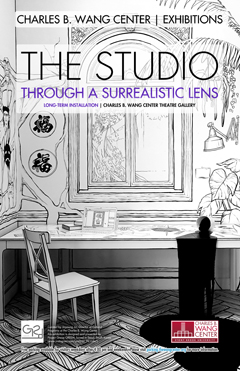
The Studio:
Through a Surrealistic Lens
Long-Term Installation
Charles B. Wang Center Theatre Gallery
White, flat, dreamlike spaces, serving as thresholds between the inner, subjective self and the external, physical world, were a subject that fascinated the South Korea-based project group GREEM (a name that literally translates to “picture” in Korean). GREEM’s goal is to elicit feelings of strangeness, difference, curiosity, and fun in its audiences. Following a long and rich Surrealist tradition, GREEM draws inspiration from dreamlike narratives, absurd juxtapositions, and comic books for new graphic languages.
A huge, flattened, and cartoon-like artist’s studio in white and black is open, inviting viewers to live out their surrealistic fantasies. The realistic detailing of the artist’s studio also adds touches of humor, utility, and everyday-ness. As soon as the viewer enters the studio (which is carefully modeled and gives the illusion of a three-dimensional form), surrealistic dreams are triggered; the white, flat scene and the viewer’s point of view are disrupted.
The current exhibition is designed to be reproduced and seen on social media as much as it is meant to be enjoyed in its actual location. This imaginative exhibition crosses perspective, culture, and media.
Curated by Jinyoung Jin, Director of Cultural Programs at the Charles B. Wang Center, this exhibition is designed and presented by Project Group GREEM, based in Seoul, South Korea.
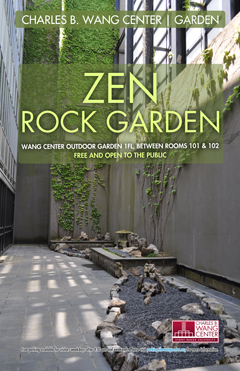
Zen Rock Garden
Long-Term Installation
Charles B. Wang Center Outdoor Garden
Located on the first floor, in between the meeting rooms 101 and 102 at the Charles B. Wang Center, this Japanese rock garden (枯山水 karesansui) was created by Gerard Senese and his wife Hiroko Uraga-Senese as a tribute to the appreciation of Japanese culture. Japanese gardens are rich with symbolism, and they are usually created with certain meanings and wishes in mind. The Wang Center's new Zen garden features symbols of Buddhist paradises with a tortoise islet (kame-jima) and a crane islet (tsuru-jima). Made with rocks, the tortoise symbolizes prosperity and the crane symbolizes health and good luck.
